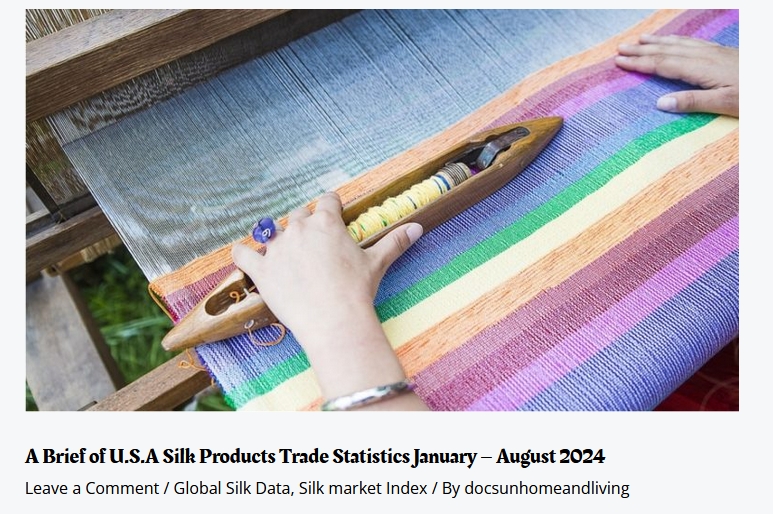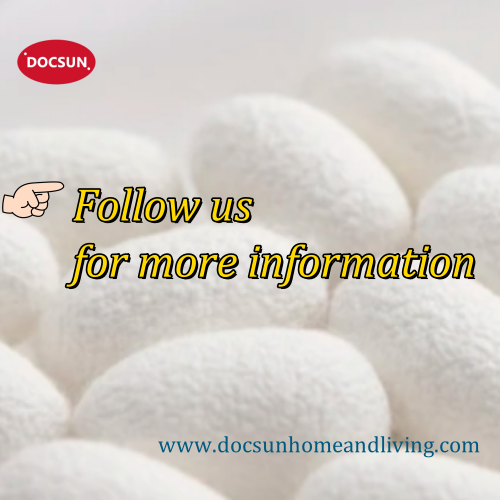Leave a Comment / Global Silk Data, Silk market Index / By docsunhomeandliving
Author: Grace Pan
Date: 15 Nov 2024
On November 8, 2024, we published our blog post named ‘the U.S. Silk Product Trade Statistics Brief for January-August 2024’. (https://blog.docsunhomeandliving.com/a-study-of-u-s-silk-consumption-and-industry-in-2024-based-on-the-u-s-international-silk-trade-statistics-jan-aug-2024/), which is a reprint from the U.S.A Department of Commerce by China Chamber of Commerce. Here in this article, I would like to apply my further analysis together with more information collected based on these statistics.

U.S. as a Silk Consumer
From January to August, the total export value of the U.S. all silk products is USD 468 million. Comparing with the total import value of USD 3.423 billion during the same period, the exports only take 13.6% of the imports.
This finding indicates that the U.S. is primarily a consumer rather than a producer of silk products. The import value for silk products (USD 3.423 billion) vastly exceeds the export value (USD 468 million), indicating that the U.S. imports much more silk than it exports. This high import-to-export ratio suggests that the U.S. market relies heavily on silk products sourced from other countries to meet domestic demand rather than producing silk goods locally.
The statistic report then categorises U.S. silk imports by product types, suggesting that the largest share of consumption includes:
- Silk Finished Products: This category likely covers a range of items, such as silk clothing, accessories, and home textiles, which tend to have high demand among U.S. consumers. The total value from January to August reaches USD 3.27 billion.
- Silk Fabrics: These are used in high-end fashion and luxury industries within the U.S., indicating a significant demand for raw or semi-finished silk materials used in local manufacturing or by designers. The total value from January to August is USD 133.38 million.
- Raw silk: Most goods of this category are in the form of silk yarn, which is primarily used in weaving and knitting to produce fabrics for luxury clothing, accessories, home textiles, and sometimes in embroidery and handcrafts for added texture. The total value from January to August is USD 12.74 million.

As the silk finished products took more than 95% of the import value, it strongly shows that the U.S. is more likely to buy silk products directly for the retail industry rather than having a strong silk textile industry. The high import volume of finished silk products indicates that U.S. businesses primarily bring in ready-made silk items for direct sale to consumers, such as in fashion, accessories, and home decor.
Additionally, the reliance on imported silk fabrics and yarn, rather than local production, implies that while there may be some niche markets and designers using silk materials, there isn’t a large-scale silk textile manufacturing base in the U.S.
This pattern suggests that the U.S. silk industry focuses on retailing imported silk products rather than producing and exporting silk textiles domestically, positioning the country more as a consumer market for silk goods.
Who are supplying silk products to the Americans?
The report also reveals the main suppliers of silk finished products to the U.S. As the three of the top four countries in the chart, China (USD 1 billion), India (USD 260 million) and Vietnam (USD 262 million) jointly took 46.8% of the total import value. These countries dominate the silk supply chain for several reasons:
- Abundant Raw Silk Production: China, in particular, is the largest producer of raw silk globally, providing a steady supply of materials needed to manufacture silk products. India also has a significant raw silk production industry, making both countries ideal for sourcing finished silk goods.
- Established Silk Manufacturing Expertise: These countries have long histories and expertise in silk craftsmanship, with skilled labour capable of producing high-quality silk garments, accessories, and home textiles at competitive costs.
- Cost-Effectiveness: Labour and production costs are generally lower in these countries than in the U.S., allowing them to produce silk finished products more affordably. This cost advantage makes them attractive suppliers to the U.S. retail market, where competitive pricing is essential.
- Supply Chain and Export Infrastructure: China, India, and Vietnam have well-developed textile export industries, with established logistics and shipping networks that make it easier to supply the U.S. market efficiently.

These factors make China, India, and Vietnam the top suppliers of silk finished products to the U.S., meeting consumer demand for affordable, high-quality silk items in the retail market.
Interestingly, regardless of the costs, we can also see the European Union (EU) serves as a significant supplier of silk finished products (USD 354 million) to the United States, primarily exporting high-quality items such as luxury apparel, accessories, and home textiles. These products are often distinguished by superior craftsmanship and design, catering to the premium segment of the U.S. market.
Within the EU, Italy stands out as the principal exporter of silk finished goods to the U.S. Renowned for its rich heritage in silk production and fashion, Italy offers a diverse range of silk products, including designer clothing, scarves, ties, and luxury home furnishings. The country’s expertise in silk weaving and garment manufacturing contributes to its leading position in this sector.
Other EU countries, such as France and Germany, also contribute to the export of silk finished products to the U.S., albeit to a lesser extent. France, with its esteemed fashion houses, supplies high-end silk apparel and accessories, while Germany exports specialized silk textiles and garments.
The EU’s emphasis on quality, design, and luxury in silk products aligns with the preferences of U.S. consumers seeking premium silk items, thereby sustaining the EU’s role as a key supplier in this market.
Brief findings of U.S. silk exports
The report indicates that the U.S. silk export industry is relatively small compared to its import volume, showing that the U.S. primarily serves as a consumer market rather than a producer in the global silk trade. Here’s a breakdown of the main points:
- Export Volume and Market Scope – The export value for U.S. silk products from January to August 2024 was USD 468 million, a decrease of 5.29% year-over-year. This lower export value, especially when compared to the USD 3.423 billion import value, reflects the limited scale of the U.S. silk production and export sector.
- Primary Export Markets – The report includes tables on the export values of U.S. silk products to major markets, suggesting that U.S. exports are likely directed to select international destinations. These markets may include high-income countries or regions that geographically close to the U.S.
- Types of Silk Products Exported – Based on the categorisation in the report, U.S. silk exports likely emphasise finished products and possibly some high-quality, niche fabrics.
The U.S. silk export industry is small and focuses on premium markets and specialised products. With limited production and high import reliance, the U.S. silk export strategy likely targets luxury and niche markets abroad. This explains the relatively modest export value, as the U.S. silk industry caters to select, high-value segments instead of mass production.
To learn more about the trade situation for silk products in the United States from January to August 2024, please refer to our previous blog. For more insights on silk products, follow the DOCSUN blog. If you’re interested in silk products, visit our website. https://www.docsunhomeandliving.com/

